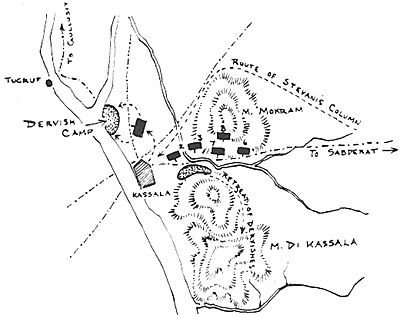
The Kassala Relief Force was thus made up of what remained of the following Askari Battalions; 3rd (Capt. Zoli); 6th (Major Cossu); 7th (Capt. deBernardis); and 8th (Major Amadasi). One section of Askari mountain artillery with two 70mm guns (lt. Racina) was also brought along. All told, the force could muster 2,500 men.
Due to the scarcity of water along the route the march had to be carried out in echelons. On the 19th Stevani set out from Agordat with the 3rd Battalion and the mountain gun section; the 7th Battalion followed on the 21st and the 6th on the 23rd. The 8th Battalion, forming the advance guard, had been on the march since the 15th.
The march to Sabderat, the concentration place for the final advance to Kassala, was not altogether succesful. the troops, most of whom had fought in the tragic battle of Adowa only a couple of weeks before, were already tired and demoralized) and they knew they would be expected to fight a new battle at the end of a forced march of 125 miles across a torrid desert. In addition, it had been impossible to find the required number of transport camels, so each man had to carry six days' rations. The few animals available were overloaded with provisions for the other four days and reserve ammunition. To avoid the sun, it was decided to proceed by night marches and in the darkness men and animals strayed frequently and many died of thirst or exhaustion.
Marching in the obscurity also offered a good opportunity for desertion and many Askaris managed to slip off unnoticed. When the column arrived at Sabderat, Stevani discovered that he had lost almost one third of his men on the way! Nevertheless, the dashing Colonel was determined to push on without delay. Between the 28th and the 31st his force was concentrated at Sabderat and on the following day the final advance was started.
Meanwhile, since the second fight of Sabderat, Ahmed Fadil's army had been gradually tightening the noose around the fort, forcing Hidalgo to call in the outside pickets. The fort was frequently subjected to the fire of Mahdist snipers, which although generally rather ineffective, occasionally caused a few casualties among the defenders. On the 25th the Mahdists placed two old Egyptian mountain guns on the slopes of Mt. Mokram. A few shells were fired at the fort, but all of them fell short and soon the Ansar artillerymen gave up their attempt at bombardment.
During the night of the 27th, the Mahdists moved to within a mile of the fort and began digging trenches and erecting stockades. The noose was being drawn tighter!
For some strange reason the Mahdists had foolishly made no further attempts to destroy the telegraph line. Stevani had been able to keep Hidalgo informed of the progress of the relief force. He was in turn informed that Mt. Mokram pass was strongly held by the enemy and ordered Hidalgo to patiently await the reinforcements, forbidding him to undertake any risky action. He also asked for a good native scout to guide the column from Sabderat. On the 27th the native requested managed to leave the fort and pass through the Mahdist lines undetected.
Hidalgo had to be content with disrupting the enemy with a few gun shots from the fort. Small scouting parties were also sent out to keep his informed of the progress of the Mahdists' siege works. Without much disturbance, the construction of the Mahdists' entrenchments continued until the fort was almost completely surrounded on the 31st.
On the afternoon of the 1st of April, after a last telegraph call to Hidalgo, Stevani moved out of Sabderat. He took Capt. Bramanti's company of the 2nd Battalion with him, deciding not to wait for Cossu's 6th Battalion, which had been the last to leave Agordat and was still on its way to Sabderat. He did, however, send Cossu a message urging him to hurry up and occupy the southern slopes of Mt. Mokram that night. When out of the gorge, Stevani formed his troops in a square formation, but not a single Mahdist was seen during the entire march.
Meanwhile, at 8:00 PM, Hidalgo, rightly assuming that the relief force was by then approaching the pass, started a heavy bombardment of the Mahdist entrenchments in order to frighten and confuse them.
Stevani was in sight of the pass by late evening. His original plan had been to fight a pitched battle to clear the pass, which he expected to be held by the bulk of the Mahdist force. But realizing that his troops were in too sorry of a state for a heavy fight, he decided to leave the main track leading into the pass and make a long detour around the north of Mt. Mokram and then skirting its western slopes. in this way he also hoped to surprise the besieging Mahdists with an unexpected attack on the rear of their entrenchments.
It was a sensible battle plan, but proved unnecessary as no attack materialized. The Mahdists manning the siege works had apparently been so impressed with Hidalgo's show of artillery power that they had abandoned their trenches and stockades, fleeing back to their camp. Stevani's force accomplished its final march without having to fire a single shot.
Siege and Relief of Kassala Italian-Mahdist Campaign
- Kassala Fortification
Kassala Relief Force
Battles of Mount Mokram and Tucruf
Uniform Notes and Plates
Back to Table of Contents -- Savage and Soldier Vol. XVII No. 2
Back to Savage and Soldier List of Issues
Back to MagWeb Magazine List
© Copyright 2004 by Milton Soong.
This article appears in MagWeb.com (Magazine Web) on the Internet World Wide Web.
Other articles from military history and related magazines are available at http://www.magweb.com